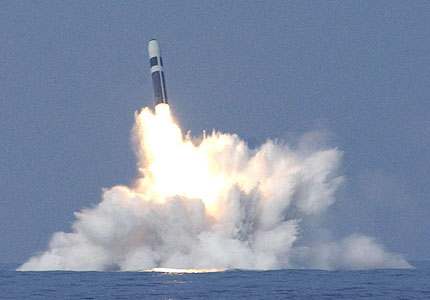
With the Soviet Union gone, the veil of deterrence Trident was hiding behind vanished
The UK's Trident missile system came into service in 1992, ostensibly as a 'deterrent' against the Cold War threat of the Soviet Union. The problem is that the Soviet Union was formally dissolved on December 26th 1991, taking with it the veil of deterrence that Trident had been hiding behind.
In reality, Trident is a 'first strike' system, capable of destroying targets almost anywhere on earth. The Trident II D-5 was designed to hit a target 100m across, 50 per cent of the time. From their submarine launchpads, Trident II missiles can reach their targets in 10-15 minutes - in comparison, land-based intercontinental missiles take 30 minutes. The Trident D-5 has a range of 7,000km or a massive 11,000km if carrying less warheads.
So nowhere is safe - a submarine in the Atlantic can attack the Middle East, Russia or China! Instead of it's apparent passive role as deterrent, Trident is instead a major factor in pressurising other nations to produce their own nuclear weapons, Iran being a perfect example.
Even if Trident was honestly believed by both the UK government and public to be the perfect deterrent, its capabilities outstretched its stated role. The missile system could be used in a first strike against the Soviet Union, or against any potential aggressor, by destroying their missiles before launch. Trident put Soviet commanders in a 'use them or loose them' position - they would either be forced to launch, or risk loosing their missiles. This meant that a false radar warning could lead to nuclear war, as Soviet commanders might believe they had no time to check whether they really were under nuclear attack, or whether the warning was triggered by a computer glitch or a flock of geese.
Since the collapse of the Soviet Union, Trident has been repositioned as essential for securing the UK's 'vital interests' such as overseas trade, investment and resources including oil. The 2002 UK New Chapter to the Strategic Defence Review declared Trident "the ultimate security of the UK" and "a means of deterring major military threats". However, the document goes further, suggesting that Trident may be used pre-emptively "in the face of an imminent attack". In 2003, UK Defence Secretary Geoff Hoon emphasised that the UK would use Trident in Iraq if chemical or biological weapons threatened British troops.
This demonstration of the UK's new 'positioning' of Trident is in line with US military policy. The Bush administration, in the 2002 Nuclear Posture Review, suggested the use of nuclear weapons in a pre-emptive role, to the point - in a bizarre public relations spin - of re-classifying nuclear weapons as 'conventional' tools of warfare.
During 2002 and 2003, the Bush administration formulated a greater need for pre-emption, prompting the US military to create a strike plan (known as CONPLAN 8022) which deals with the operational aspects of pre-emptive strikes. Trident is listed as a tool with major advantages: "no risk to crew, can be launched in international waters, has a short flight time, stealth and surprise can be achieved prior to launch, flexible targeting capability."
Each of the four UK Trident submarines can carry 16 Trident missiles, each of which can carry 12 warheads - a potential of 192 warheads. Since 1998, UK Trident submarines carry just 48 warheads, or an average of three warheads per missile. However, because of potential sub-strategic use, some missiles carry just one warhead. To put this in perspective, each warhead can deliver a destructive blast eight times that of the Hiroshima bomb.
Trident is not a 'UK' weapons system - this is another well-worn myth. Nearly all of the weapon parts are sourced or leased from the US, with few exceptions, such as the warhead, is manufactured in the UK based on the US W76 design. The software, targeting and weather data are all US-sourced. Even Aldermaston, the UK's development facility, is part-managed by Lockheed-Martin Corporation while Devonport, the UK naval base in Plymouth, is part-managed by controversial US corporation Halliburton.
There is also extensive cooperation between Aldermaston and US nuclear laboratories like Los Alamos in New Mexico and both Sandia and Lawrence Livermore in California. Even UK testing was done in the US as the UK has no test zone for such manoeuvres. While the warhead was tested in Nevada in the early 1990s, the 'British' missiles themselves were test launched at Cape Canaveral under US supervision.
The continued development of Trident threatens both the Nuclear Non Proliferation Treaty and world stability. It's time to take Trident off patrol.

